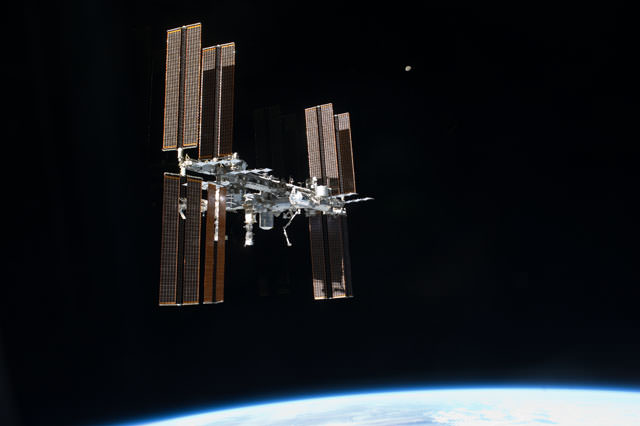[/caption]
It’s the gift that keeps on giving, unfortunately. Debris from the 2009 collision between an inactive Russian Cosmos 2251 satellite and a commercial Iridium satellite in low Earth orbit is coming dangerously close to the International Space Station. U.S. Space Command has suggested the space station perform a debris avoidance maneuver on Friday, January 13, 2012 to move out of harms’ way and dodge a possible collision with the piece of space junk, said to be about 10 centimeters in diameter.
UPDATE: The ISS has successfully been boosted about 300 meters (1,000 feet) by firing the thrusters on the Zarya module for 54 seconds.
This will be the 13th time since 1998 that the station has moved because of debris.
The thrusters on the Zvezda service module are planned to burn at 1610 UTC (11:10 a.m. EST) on Friday. Without the maneuver, the object would have made two close approaches to the station on consecutive orbits on Friday, passing within the “pizza box” -shaped region around the station, measuring 0.75 kilometers above and below the station and 25 kilometers on each side (2,460 feet above and below and 15.6 by 15.6 miles). NASA said ISS flight controllers are preparing for the maneuver and the crew onboard has been informed.
This debris avoidance maneuver does have one benefit, as the station needed a reboost anyway, and so it will eliminate the need for a reboost of the station next week. The reboost had been planned to put the station at the proper altitude for the launch and docking later this month of the ISS Progress 46 cargo ship.
There are more than 20,000 pieces of debris larger than a softball orbiting the Earth. They travel at speeds up to 17,500 mph, fast enough for a relatively small piece of orbital debris to damage a satellite or a spacecraft. There are 500,000 pieces of debris the size of a marble or larger. There are many millions of pieces of debris that are so small they can’t be tracked.
NASA says that even tiny paint flecks can damage a spacecraft when traveling at these velocities. In fact a number of space shuttle windows have been replaced because of damage caused by material that was analyzed and shown to be paint flecks.
“The greatest risk to space missions comes from non-trackable debris,” said Nicholas Johnson, NASA chief scientist for orbital debris.
Debris avoidance maneuvers are conducted when the probability of collision from a conjunction reaches specific limits set for the Space Station flight rules. If the probability of collision is greater than 1 in 100,000, a maneuver will be conducted if it will not result in significant impact to mission objectives. If it is greater than 1 in 10,000, a maneuver will be conducted unless it will result in additional risk to the crew.
These collision avoidance maneuvers for the ISS require about 30 hours to plan and execute, mainly due to the need to use the station’s Russian thrusters, or the propulsion systems on one of the docked Russian or European spacecraft.
Source: NASA


These manouvers cost propellent so they cost significant amount of money. This to me is more justification why a space debris removal plan is required, if the X37 can be re-used quickley and cheaply this would be an ideal mission, match orbits with junk on close orbits and capture and either return to earth or release just before re-entry to burn up.
You’d have to weigh up the costs of avoidance-manoevres against the costs of disposing of the space junk though… using the X37 for that could easily work out to be a bigger investment.
What we need is a cheap and novel way to dispose of space junk.
Before anybody says anything, I’ve already e-mailed a note to Nancy about the typo in the title. 😉